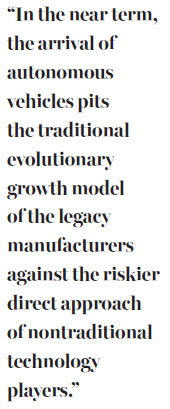Autonomous driving has long road to go

Sheer scale and number of legislative, infrastructural and technological barriers will slow the rate of adoption
Since the days of the horse and cart, people have proudly owned and lovingly cared for their analog conveyance. But digital is breaking that bond as it expands the boundaries of possibility - and we're approaching a time when there may no longer be drivers.
Through the twin paths of assisted driving and self-driving, autonomous vehicles have features unheard of not many years ago. Cars can park themselves and cruise hands-free on highways, and with the pending arrival of full autonomy we'll all be travelers using various forms of transportation that will be part of a seamless connected continuum coasting on roads that could be congestion-free.
The potential impact? Nothing short of revolutionary.
Wide-scale adoption will lead to unprecedented economic, social and environmental change. For the public, the independence and freedom of personal travel will be available to almost everyone - youth, seniors and the physically, mentally and visually impaired.
The expected reduction of road congestion will bring wide-ranging work and personal benefits. The gains from a drop in vehicle accidents and deaths are obvious. The major players in the market are pursuing the development of autonomous vehicles. Many Chinese original equipment manufacturers are also investing in both improving assisted driving capabilities and simultaneously exploring fully self-driving technologies.

However, as elsewhere in the world, the widespread commercialization of autonomous vehicles in the Chinese market in the immediate future is hindered by technical constraints, legislative wariness, infrastructure barriers, unpredictable consumer acceptance and cost of development.
Assisted driving is already a reality, but the age of most vehicles on the road (9 to 11 years old) is delaying the realization of pervasive assisted driving capabilities. In the medium term, many of the assisted driving features that now exist in premium-brand cars will be more affordable and more common in mass-produced vehicles.
According to the World Economic Forum's Digital Transformation of Industries study, vehicle safety will be improved, as advanced driver assistance systems and electronic stability control installations could reduce the risk of crashes by 9 percent by 2025, avoiding 5 percent of the additional premiums consumers would have had to pay in the event of their vehicles being less safe.
More importantly, the enhanced safety has the potential to save about 900,000 lives over the next 10 years by preventing fatal incidents. The report predicts the economic benefits of assisted driving to consumers and society could exceed $1 trillion over the next 10 years, while auto manufacturers and suppliers can unlock the next wave of "trapped industry value" of up to $1 trillion through greater customer adoption and related regulatory approvals of assisted driving technologies.
Self-driving has drawn intense media attention, and is already a reality in proof-of-concept testing around the world. Several technology companies are working on creating vehicles capable of navigating themselves through mixed traffic conditions on all roads and highways. The best known project now in development is from Google. The company is interested in not only the automotive industry for its own sake, but to defend and strengthen their core business in advertising and data revenue business models. It has courted manufacturing partners, but none have emerged.
Even as the legacy automakers are developing new driver-assist technologies, many have parallel autonomous-vehicle projects well underway. Audi, BMW, Mercedes-Benz, Nissan and Toyota are among the players experimenting with self-driving vehicles.
In April, two self-driving vehicles, produced by Chinese automaker Changan Automobile, drove 2,000 kilometers from Chongqing to Beijing in six days.
As the two modes of autonomous vehicle continue to advance, the number of automated vehicles will grow. However, the sheer scale and number of legislative, infrastructural and technological barriers will slow the rate of adoption.
In the near term, the arrival of autonomous vehicles pits the traditional evolutionary growth model of the legacy manufacturers against the riskier direct approach of nontraditional technology players. The route to critical mass adoption of autonomous vehicles isn't clear. Acceptance may occur after years of incremental introductions of discrete autonomous functions, or more quickly, through the direct development of the radical new technology of autonomous driving.
Significant questions also loom with regard to consumer confidence. Can we trust these systems with our lives? Are autonomous cars physical extensions of the personal data-hungry technology companies that made them? Will we have any control or at least an emergency override switch if the machine brain malfunctions?
Consequently, the production of autonomous vehicles will require a full transformation of the automotive operation and its support ecosystem. To ensure public trust and avoid high litigation costs, managing cybersecurity risks will also be imperative.
The author is Accenture Strategy's managing director in China. The views do not necessarily reflect those of China Daily.
(China Daily European Weekly 06/24/2016 page9)
Today's Top News
- Takaichi must stop rubbing salt in wounds, retract Taiwan remarks
- Millions vie for civil service jobs
- Chinese landmark trade corridor handles over 5m TEUs
- China holds first national civil service exam since raising eligibility age cap
- Xi's article on CPC self-reform to be published
- Xi stresses improving long-term mechanisms for cyberspace governance






























